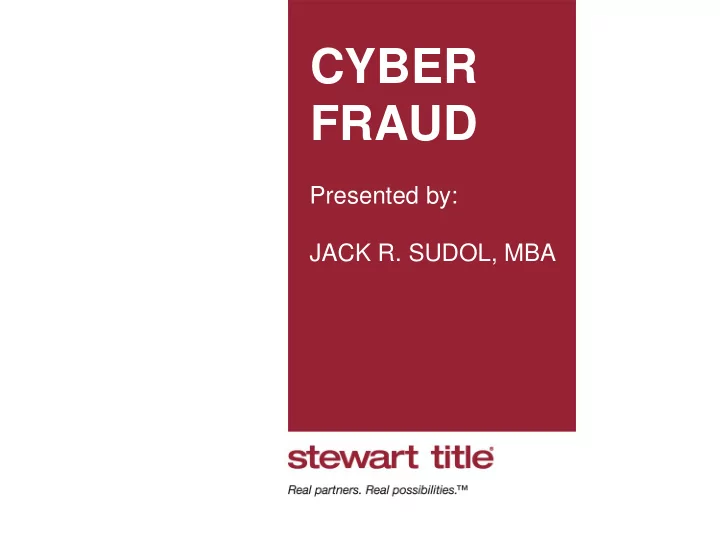

CYBER FRAUD Presented by: JACK R. SUDOL, MBA
Cyber Fraud
FBI Announcement • Between October 2013 and December 2016 the FBI reported 40,203 incidents of BEC/EAC totaling $5.3 Billion Dollars of Losses! • The number of wire fraud scams reported by title companies spiked 480% in 2016 (ALTA article dated 5/9/17)
New Jersey Statistics • 2016 Cyber Crime losses in New Jersey totalled $24,500,833. • Of the top-30 Cyber Crimes we have: – 16.) Phishing • 575 Victims • $401,737 in Loss – 9.) Real Estate or Rental • 270 Victims • $1.35 Million in Loss – 1.) Compromised Email Accounts • 292 Victims • $8.69 Million in Loss
Two Most Common Scams • Business Email Compromise (BEC) – This scam targets those businesses that work with vendors and/or other businesses that perform wire payments. • Email Account Compromise (EAC) – This scam targets individuals directly that perform wire transfer payments.
Why are we here? • Malware • Spyware • Ransomware • *** Social Engineering • *** Phishing
Social Engineering Social engineering, in the context of information security, refers to psychological manipulation of people into performing actions or divulging confidential information. A type of confidence trick for the purpose of information gathering, fraud, or system access, it differs from a traditional “con” in that it is often one of many steps in a more complex fraud scheme.
Social Engineering Can… • Learn about you (via LinkedIn, Facebook, etc.) • Send infected attachments • Install malware • Deliver malicious links
Social Engineering Do’s and Don’t • Keep your business and • Don’t accept invitations personal life separate from people you don’t know • Be suspicious of any URL links in emails • Be aware of all email attachments • Use reputable email services • Protect your credentials
Phishing
Phishing Is the attempt to obtain sensitive information for malicious reasons and monetary gain by disguising a trustworthy entity in an electronic communicator. Phishing schemes are usually addressed to the target and contain relevant content as a result of thorough research.
Phishing can lead to… • Credential harvesting • Redirecting to malicious websites • Installing malicious software • Downloading malicious attachments
Phishing Do’s and Don’t • Scrutinize every link • Don’t download attachments you are • Go to websites directly not expecting • Beware of attachments • Don’t click on links • Keep your operating • Don’t respond to system and browser up original emails to date
Anatomy of a Wire Fraud
Watch for Red Flags • Misspelled email domains – Double letters – Look-a-likes – Vowels replaced • Different email domains – Free domains • Changes in the footer • Changes in the style
For individuals • Don’t click on links embedded in emails • Download software only from trusted sources • Unplug your internet connection when you’re away • Don’t send sensitive files over Wi - Fi or “hot spots” • Never reply to emails that ask for personal information
For Companies • Avoid free web based emails – use private domain email address • Encrypt your email communication that contains NPI • Limit or ban access to social media websites on office computers • Include a warning in your email signature • Confirm wiring instructions before sending emails
For Companies • Use the “Forward” option rather than the “Reply” option to respond to business emails • Fax wiring instructions • Consider implementing a “two - factor” authentication to confirm requests for transfer of funds • Scrutinize all email requests for transfer of funds and beware of sudden changes in business practices. • Obtain Cybercrime coverage
Best Practices • Obtain an Escrow Security Bond with Cyber Coverage to protect against fiduciary losses • Reconcile escrow/trust accounts timely • Adhere to ALTA best practices
Thank You Questions?
Recommend
More recommend